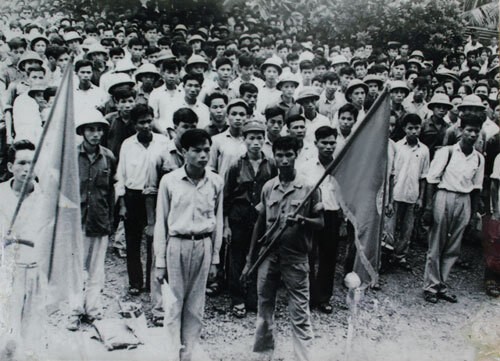 Students of the National Economics University leave for the army in September, 1971. (Photo: VNA) Students of the National Economics University leave for the army in September, 1971. (Photo: VNA) |
Between 1970 and 1974, more than 10,000 university students gave up their studies in Hanoi to join the army. Most of them were from the Hanoi University of Science and Technology, the Vietnam National University, Vietnam National University of Agriculture, the National University of Civil Engineering, the National Economics University, and the Hanoi Education University. Some were freshman students and others were about to study abroad.
Phung Huy Thinh, former student of the Vietnam National University in Hanoi, said: “I had written a letter to volunteer to join the army even before the official military call-up letter reached me. Everybody did so. One of my friends from Quang Binh province even used his blood to write the volunteer letter. The official military call-up letters fulfilled our desperate aspiration to defend our home country.”
The biggest military recruitment was in 1971. The new school year coincided with official military letters call of duty. On September 6, 1971, send-off ceremonies were held at many school yards in Hanoi drawing both students and teachers. All the student-soldiers showed their optimism in joining the army while still wearing their school uniforms. In 1972 all new soldiers were sent to a training course on tactics, weapon use, and combat capability before being transported by train from Bac Giang province to Vinh city in central Nghe An province. From there they would march to their battle fields.
Truong Van Luong, a student soldier at that time, recalled: “While we were on a camping trip in Bac Giang province, we received an order to gather at a local train station to head to the front line. From the train’s speakers, we heard songs about the joy of young people marching to the battlefields and how beautiful the scenery is on the way. We passed by the Hanoi train station on the 28th day of the last lunar month when locals were buying peach blossoms and kumquat trees to prepare for the traditional New-Year festival.”
Young soldiers brought along books and notebooks. They often sent letters to teachers and friends back home along their way to the battle fields. After finishing their service, they wrote diary letting their families and friends know about the war as well as their life experience, dreams, and aspirations.
Nguyen Van Khanh, once a student of the Hanoi Medical University, said: “On the way to Quang Tri province, one of the fiercest battle fields in the central region, I carried with me some photos and a diary that I wrote since becoming a student. When I crossed the Lai Phuoc river, a bombshell was fired to our position. One of my medical team members rushed to me and broke the lifebuoy. As a result, water flowed into my backpack and destroyed my diary and all the photos. I didn’t blame it on him as damages were inevitable in wartime. But I was heart-broken when losing these memorial items.”
Hanoi student troops participated in the harshest battles from Quang Tri province to the southeastern region, from Buon Ma Thuot city in the Central Highlands to Ho Chi Minh city.
Le Van Cuong, a former student of the National University of Civil Engineering, told us: “We suffered a lot from 1972 to 1975, not only at the fierce Quang Tri battle but also elsewhere. Our combat capabilities grew steadily. We were no longer timid as in our first military days.”
Only a small number of the 10,000 students returned home after victory day. They had the most casualties during the 81-day battle to defend the Quang Tri ancient citadel in 1972. Many others laid down their lives on the southern fronts and in Laos. Some lost their lives as they entered Saigon just a couple of hours prior to reunification. Some of them became Heroes of the People's Armed Forces.
Nguyen Van Khanh, former student of the Hanoi Medical University, again: “Student soldiers have turned into a trademark of the youthfulness, wisdom, and courage.”
When the war ended, many student soldiers resumed their studies to became scientists, officials, military commanders, and authors. Their sacrifice for national liberation instilled a great source of pride in the younger generations and will be forever remembered.